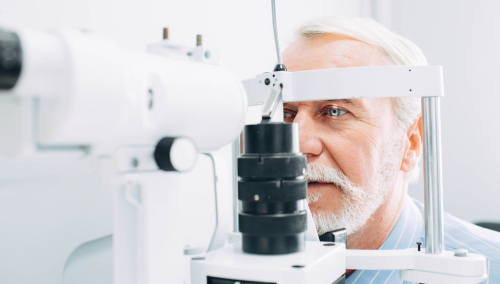Do Eye Doctors Test for Cataracts During Routine Exams?
January 12th, 2023
The part of the eye where cataracts form is a structure that eye doctors examine during every comprehensive eye exam. While specific cataract testing is not typically a part of a routine exam, if changes in your eyes indicate the presence of cataracts, further testing may be done.
Cataracts are easily visible during an eye exam because the natural lens inside your eye begins to cloud as a cataract develops. Cataracts are most common in older adults over the age of fifty.
A cataract forms as proteins begin to break down and clump together within the eye’s natural lens, which can cause vision loss and other symptoms.
Keep reading to learn more about how eye doctors test for cataracts during routine exams!
Testing for Cataracts
Here are some of the ways your eye doctor can test for the presence of cataracts.
Visual Acuity Test
This test measures the quality of your vision. Your eye doctor will ask you to look at a chart of letters that are large at the top and grow smaller with each line. Your eyes will be tested one at a time to measure your vision.
Slit-Lamp Exam
This specialized microscope allows your eye doctor to see the structures at the front and back of your eye under magnification. It uses an intense line of light to illuminate your eye to look at different parts of your eye, like your cornea, iris, retina, and lens.
It allows your eye doctor to view these structures in small sections to determine if there are any slight abnormalities. In order to look at the retina at the back of your eye, your eye doctor will give you dilation drops to make your pupil large.
This is a very important part of a comprehensive eye exam. Once the drops are in effect, your eye doctor will be able to get a better view of the back of your eye, including the retina and optic nerve.
Tonometry Test
This test measures the intraocular pressure of your eye, which can be elevated in people with glaucoma.
Symptoms of Cataracts
If one or more of the following interfere with your vision, you may have cataracts.
Light Sensitivity
Going into bright daylight from an indoor space, you may need a couple of seconds to adjust to the changing conditions. This is known as light sensitivity and can indicate the presence of cataracts.
Glare and Halos Around Lights
Especially noticeable at night, bright lights against a dark background create a glare, flare, or appear to have a rainbow halo around them. This is another common symptom of cataracts.
Harder to Drive at Night
The glare of headlights from oncoming traffic, or the flare of bright light triggering light sensitivity, can create difficulty in nighttime driving.
Difficulty Focusing in Dim Light
If you’ve ever tried to read a menu in an intimate restaurant with low lighting, you know that focusing is hard. Or if you’re reading a book, you need a bright light source. This can be caused by cloudy cataracts.
Double Vision
When cataracts form, your inability to focus can lead to double vision. You may see two sets of sentences when reading. It can be hard to watch television or a movie.
Cataract Treatment
The best treatment for cataracts is cataract surgery. During cataract surgery, your cataract surgeon will remove the cloudy lens and replace it with a new artificial one to improve your vision.
It’s a safe and effective procedure that can allow you to see clearly once again. Don’t let compromised vision slow you down!
Are you experiencing symptoms of cataracts? Schedule a cataract evaluation at Laser Eye Center in Hunstville, AL, today!



